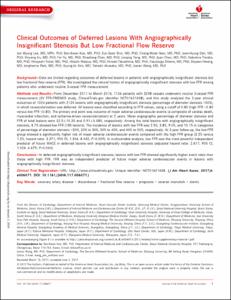KUMEL Repository
1. Journal Papers (연구논문)
1. School of Medicine (의과대학)
Dept. of Internal Medicine (내과학)
Clinical Outcomes of Deferred Lesions with Angiographically Insignificant Stenosis but Low Fractional Flow Reserve
- Keimyung Author(s)
- Nam, Chang Wook
- Department
- Dept. of Internal Medicine (내과학)
- Journal Title
- Journal of American Heart Association
- Issued Date
- 2017
- Volume
- 6
- Issue
- 8
- Keyword
- coronary artery disease; discordance; fractional flow reserve; prognosis; reverse mismatch; stents
- Abstract
- BACKGROUND:
Data are limited regarding outcomes of deferred lesions in patients with angiographically insignificant stenosis but low fractional flow reserve (FFR). We investigated the natural history of angiographically insignificant stenosis with low FFR among patients who underwent routine 3-vessel FFR measurement.
METHODS AND RESULTS:
From December 2011 to March 2014, 1136 patients with 3298 vessels underwent routine 3-vessel FFR measurement (3V FFR-FRIENDS study, ClinicalTrials.gov identifier NCT01621438), and this study analyzed the 2-year clinical outcomes of 1024 patients with 2124 lesions with angiographically insignificant stenosis (percentage of diameter stenosis <50%), in which revascularization was deferred. All lesions were classified according to FFR values, using a cutoff of 0.80 (high FFR >0.80 versus low FFR ≤0.80). The primary end point was outcome of major adverse cardiovascular events (a composite of cardiac death, myocardial infarction, and ischemia-driven revascularization) at 2 years. Mean angiographic percentage of diameter stenosis and FFR of total lesions were 32.5±10.3% and 0.91±0.08%, respectively. Among the total lesions with angiographically insignificant stenosis, 8.7% showed low FFR (185 lesions). The incidence of lesions with low FFR was 2.5%, 3.8%, 9.0%, and 15.1% in categories of percentage of diameter stenosis <20%, 20% to 30%, 30% to 40%, and 40% to 50%, respectively. At 2-year follow-up, the low-FFR group showed a significantly higher risk of major adverse cardiovascular events compared with the high FFR group (3.3% versus 1.2%, hazard ratio: 3.371; 95% CI, 1.346-8.442; P=0.009). In multivariable analysis, low FFR was the most powerful independent predictor of future MACE in deferred lesions with angiographically insignificant stenosis (adjusted hazard ratio: 2.617; 95% CI, 1.026-6.679; P=0.044).
CONCLUSIONS:
In deferred angiographically insignificant stenosis, lesions with low FFR showed significantly higher event rates than those with high FFR. FFR was an independent predictor of future major adverse cardiovascular events in lesions with angiographically insignificant stenosis.
CLINICAL TRIAL REGISTRATION:
URL: http://www.clinicaltrials.gov. Unique identifier: NCT01621438.
- Keimyung Author(s)(Kor)
- 남창욱
- Publisher
- School of Medicine (의과대학)
- Citation
- Joo Myung Lee et al. (2017). Clinical Outcomes of Deferred Lesions with Angiographically Insignificant Stenosis but Low Fractional Flow Reserve. Journal of American Heart Association, 6(8), e006071–e006071. doi: 10.1161/JAHA.117.006071
- Type
- Article
- ISSN
- 2047-9980
- Appears in Collections:
- 1. School of Medicine (의과대학) > Dept. of Internal Medicine (내과학)
- 파일 목록
-
-
Download
 oak-2018-0244.pdf
기타 데이터 / 1.58 MB / Adobe PDF
oak-2018-0244.pdf
기타 데이터 / 1.58 MB / Adobe PDF
-
Items in Repository are protected by copyright, with all rights reserved, unless otherwise indicated.